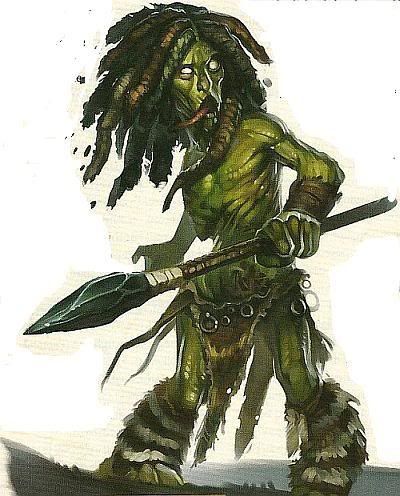Dungeons & Dragons 5e Monster : Vegepygmy
Remove these ads. Join the Worldbuilders Guild
Vegepygmy CR: 1/4
Small plant, neutral
Armor Class: 14
Hit Points: 9
Speed:
30 ft
STR
13 +1
DEX
12 +1
CON
13 +1
INT
2 -4
WIS
10 +0
CHA
6 -2
Skills: Skills Perception +2, Stealth +4
Damage Resistances: Lightning, Piercing
Senses: Darkvision 60 ft., Passive Perception 12
Languages: Vegepygmy
Challenge Rating: 1/4
Plant Camouflage. The vegepygmy has advantage on Dexterity (Stealth) checks it makes in any terrain with ample obscuring plant life. Regeneration. The vegepygmy regains 3 hit points at the start of its turn. If it takes cold, fire, or necrotic damage, this trait doesn’t function at the start of the vegepygmy’s next turn. The vegepygmy dies only if it starts its turn with 0 hit points and doesn’t regenerate.
Actions
Claws. Melee Weapon Attack: +4 to hit 1d20+4 , reach 5 ft., one target. 1d6+2 Hit: 5 (1d6 + 2) slashing damage. Sling. Ranged Weapon Attack: +4 to hit 1d20+4 , range 30/120 ft., one target. 1d4+2 Hit: 4 (1d4 + 2) bludgeoning damage.
Vegepygmies are fungus creatures that live in simple tribal units, hunting for sustenance and spreading the spores from which they reproduce.
Primitive Plants. Vegepygmies, also called mold folk or moldies, inhabit dark areas that are warm and wet, so they are most commonly found underground or in dense forests where little sunlight penetrates. A vegepygmy instinctively feels kinship with other plant and fungus creatures, and thus vegepygmy tribes coexist well with creatures such as myconids, shriekers, and violet fungi.
Although they prefer to eat fresh meat, bone, and blood, vegepygmies can absorb nutrients from soil and many sorts of organic matter, meaning that they rarely go hungry. A vegepygmy can hiss and make other noises by forcing air through its mouth, but it can’t speak in a conventional sense. Among themselves, vegepygmies communicate by hissing, gestures, and rhythmic tapping on the body. Vegepygmies build and craft little; any gear they have is acquired from other creatures or built by copying simple construction they have witnessed.
Mold Begets Mold. Vegepygmies originate from the remains left behind when a humanoid or a giant is killed by russet mold. One or more vegepygmies emerge from the corpse a day later. If a beast such as a dog or a bear dies from russet mold, the result is a bestial moldie called a thorny result instead of a humanoid-shaped vegepygmy. Thornies are less intelligent than vegepygmies, but have greater size and ferocity, as well as a thorn-covered body.
As a vegepygmy ages, it grows tougher and develops spore clusters on its body. Spore-bearing vegepygmies are deferred to by other vegepygmies, so outsiders refer to such vegepygmies as chiefs. A chief can expel its spores in a burst, infecting nearby creatures. If a creature dies while infected, its corpse produces vegepygmies the same way russet mold does.
No one knows for sure where russet mold came from. One historical account tells of adventurers in a forbidding mountain range discovering russet mold and vegepygmies in a peculiar metal dungeon full of strange life. Another story says that explorers found russet mold in a crater left by a falling star, with vegepygmies infesting the dense jungle nearby.
Suggested Environments
forest, swamp, alien






